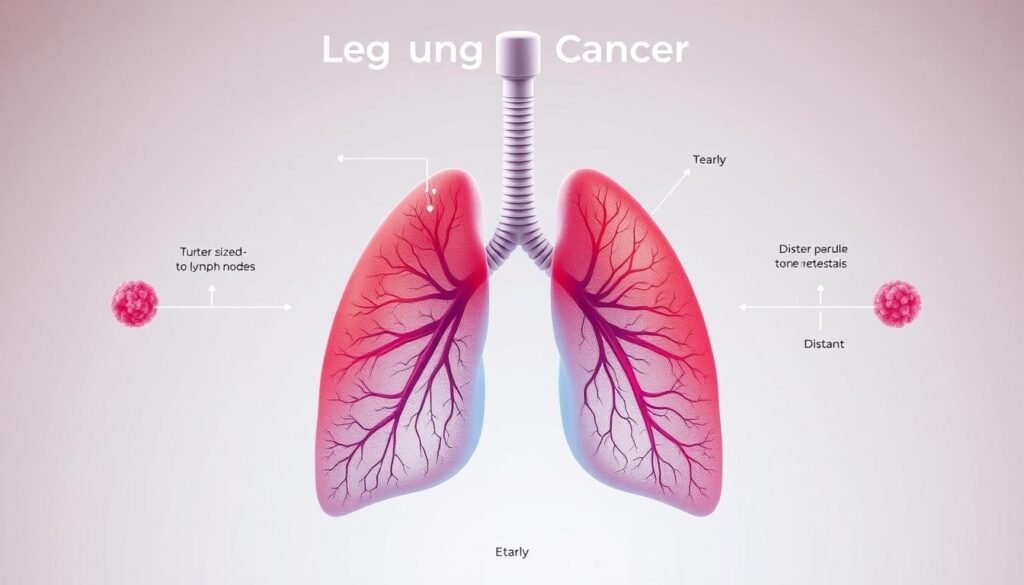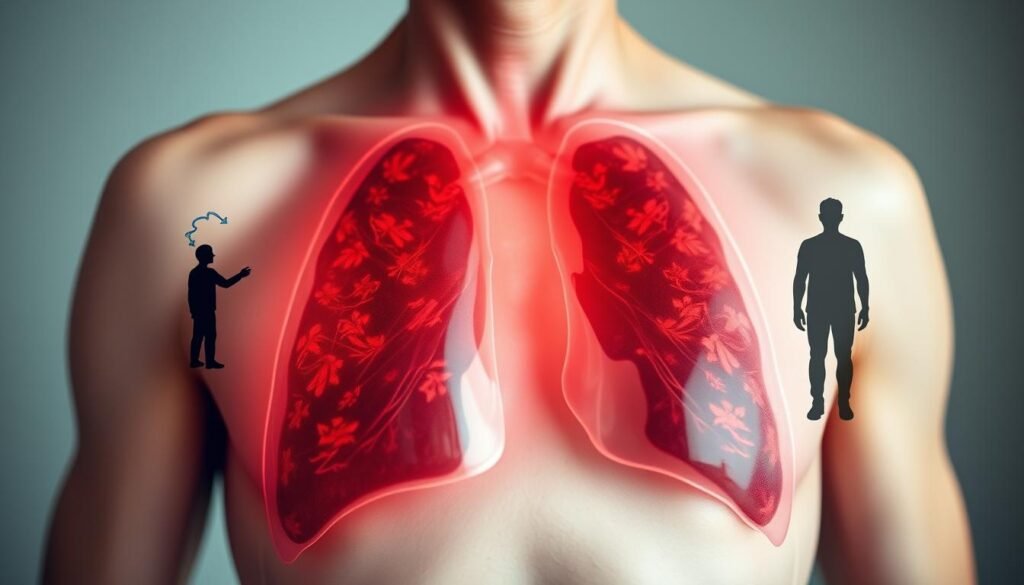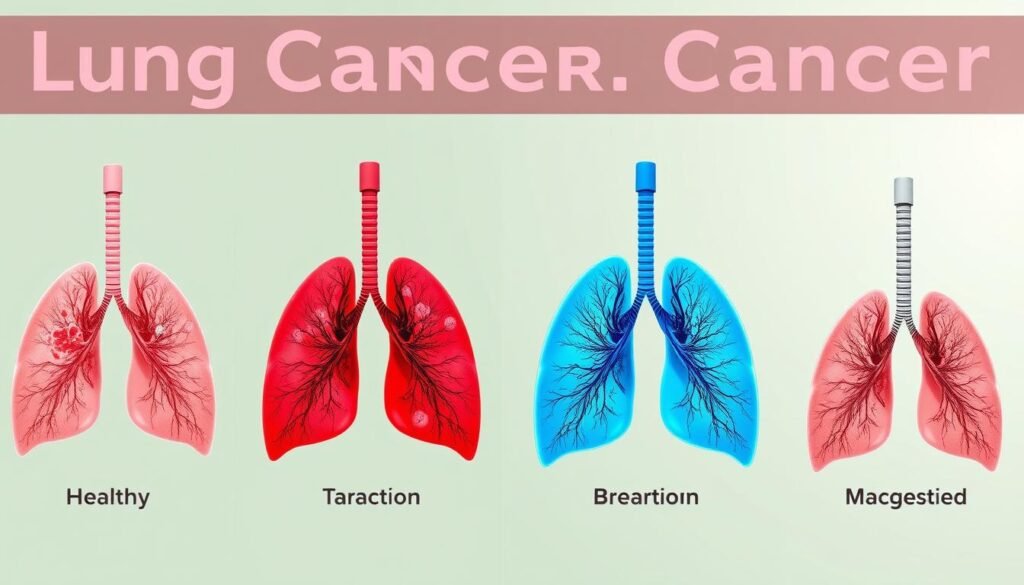Did you know lung cancer is the top cause of cancer deaths around the globe? It takes about 1.8 million lives yearly. Recognizing how symptoms link to lung cancer stages is crucial. It changes treatment choices and can help save lives.
Lung cancer’s early signs are often hard to spot. That makes knowing what to look out for very important. Catching it early can lead to better results. This piece will talk about the different stages of lung cancer and their symptoms. We aim to make everyone more alert and informed.
Key Takeaways
- Early recognition of lung cancer symptoms can lead to better treatment outcomes.
- Understanding lung cancer stages is vital for effective diagnosis and treatment planning.
- Advanced stages can manifest more severe symptoms, necessitating comprehensive care.
- The relationship between symptoms and lung cancer stage impacts the selection of treatment options.
- Awareness of risk factors can encourage proactive health measures regarding lung cancer.
Introduction to Lung Cancer Symptoms
Lung cancer symptoms can be hard to notice early on. Many don’t see the signs until the cancer has grown. At that stage, treatment becomes more complicated. Spotting these symptoms early is crucial.
Lung cancer is a top cause of cancer deaths worldwide. *Tobacco use* plays a big part in this. Around one-third of all cancers come from tobacco. Smoking contributes to up to 90% of lung cancers. Understanding the link between smoking and lung cancer stresses the need for prevention.
Many smokers want to quit, but it’s hard. Only about 7% manage to stop. Support, like counseling and quitting aids, is key. These aids boost chances of quitting and help find lung cancer early.
https://www.youtube.com/watch?v=ihCnDjyJv5c
Knowing risk factors, like secondhand smoke and pollution, is important. Making smart health choices helps. Early detection of lung cancer symptoms means better treatment chances and outcomes.
Understanding Lung Cancer Stages
Knowing the lung cancer stages is crucial for patients and families. These stages tell us about the cancer’s size, lymph node status, and if it has spread. Each stage shows how far the lung cancer has progressed and affects treatment and outlook.
Lung cancer comes in two main forms: non-small cell lung cancer (NSCLC) and small cell lung cancer (SCLC). The staging differs for each type, leading to different treatment plans. NSCLC is often found earlier, offering more treatment choices. For instance, nearly 80% of stage 1 NSCLC patients can have surgery that is less invasive, helping them recover better.

On the other hand, small cell lung cancer usually is found at a later stage, like stage 3 or 4. This makes treatments like chemotherapy and radiation more common than surgery. The five-year survival rate for lung cancer is around 25.4% overall. But, for cancers found early, the survival rate jumps to about 62.8%. This shows why finding it early is so important.
The TNM system is key to knowing how severe the lung cancer is. It looks at tumor size (T), if the cancer has spread to lymph nodes (N), and if there’s metastasis (M). Doctors use this to create the best treatment plan. Each stage tells us more about what to expect, making it important to understand the staging of lung cancer.
In conclusion, getting the hang of lung cancer staging is vital. It helps in improving the chances of treatment working and extending patients’ lives. Understanding the stages empowers us to make choices that deeply affect the patient’s health journey.
Common Lung Cancer Symptoms
Knowing the symptoms of lung cancer is key for early detection and treatment. Often, people might ignore these symptoms, thinking they are minor health issues. But, recognizing them early is critical for getting the right help in time.
Persistent Cough
A long-lasting cough is a common early sign of lung cancer. This cough gets worse, not better, over time. At first, it may look like a cold, but if it doesn’t go away, it’s a serious red flag. If you have a cough that won’t quit, see a doctor for advice. It’s crucial for catching the disease early. Learn more about lung cancer symptoms at common lung cancer symptoms.
Coughing Up Blood
Seeing blood when you cough is a big warning sign. It means the cancer might be getting worse. This symptom is a shocker, and it makes people rush to get help. Acting quickly on this sign is important for starting treatment.
Shortness of Breath
Feeling out of breath can happen if the cancer blocks airways or causes fluid build-up. Sometimes, it’s confused with asthma or COPD. But, it could also mean lung cancer is advancing. It’s important to know the differences to spot lung cancer early. For more on telling lung cancer from other diseases, visit early signs of lung cancer.
Advanced Lung Cancer Symptoms
Lung cancer shows clear symptoms as it gets worse. Spotting these signs early is crucial for getting the right help. Patients often feel bone pain, notice changes in their brain function, and see their weight drop unexpectedly. Knowing these signs helps patients and their families find medical care sooner.
Bone Pain and Neurological Symptoms
When lung cancer spreads to the bones, it can cause a lot of pain. This pain might be constant or only in certain spots. If the cancer reaches the brain, it can lead to headaches, trouble thinking, or seizures. These problems can make someone’s health get worse quickly. That’s why it’s so important to keep an eye out for them.
Unexplained Weight Loss and Fatigue
Unexpected weight loss is a big warning sign of lung cancer. People might lose weight even if they’re not trying to. Along with dropping pounds, they may feel very tired all the time. This tiredness can make everyday tasks hard to do. Anyone having these symptoms should see a doctor for a check-up and help.

| Symptom | Description | Possible Impact |
|---|---|---|
| Bone Pain | Discomfort in bones due to metastasis | May limit mobility and quality of life |
| Neurological Symptoms | Headaches, seizures, or cognitive changes | Can lead to confusion and impaired function |
| Unexplained Weight Loss | Significant weight decrease without effort | Indicator of health decline and cancer progression |
| Fatigue | Extreme tiredness affecting daily activities | May hinder treatment adherence and lifestyle |
The Relationship Between Symptoms and Lung Cancer Stage
Knowing how symptoms and lung cancer stages connect is key for proper diagnosis and care. Studies show that certain symptoms point to different stages. For example, in early stages, lung cancer might not be obvious. About 59% of people caught in stage I don’t show symptoms.
As the cancer gets worse, the symptoms do too. Stage IV cancer, for example, brings more chest pain, breathing problems, weight loss, and tiredness. Interestingly, 27.7% of those with stage IV lung cancer don’t feel symptoms when found. This means not everyone at an advanced stage shows signs.
Some lung cancers have specific symptoms linked to them. Nonsmall cell lung cancer (NSCLC) is one, often leading to a chronic cough and coughing up blood. About 65% with NSCLC have a chronic cough. Those with squamous carcinoma and stage III cancer show similar signs. This highlights how the cancer grows.
Finding how symptoms and lung cancer stages are related helps doctors treat patients better. Understanding these signs leads to better guesses about how the cancer is moving. This improves how patients are cared for and the plans made to help them.
How Lung Cancer Progression Affects Symptoms
Lung cancer progression is key in understanding symptoms. As the disease moves through stages, symptoms get more complex. At first, symptoms like a persistent cough or shortness of breath appear.
This can lead to systemic signs as the disease worsens. For example, patients may lose weight and feel very tired as cancer spreads.
When cancer reaches an advanced stage, it greatly affects the patient’s life. Symptoms become harder to manage. Issues such as fluid around the lungs and more pain may occur. This situation might require palliative care to help with pain and discomfort.
- Advanced lung cancer stage symptoms:
- Severe shortness of breath
- Persistent cough with increased severity
- Unexplained weight loss
- Extreme fatigue
- Potential cognitive changes due to brain metastases
In late stages, survival rates drop. For stage 4 non-small cell lung cancer (NSCLC), the five-year survival is around 8 percent for spread cases. If it spreads regionally, the survival rate climbs to 37 percent.
Lung cancer does not just affect the lungs. It can spread, making treatment and symptom care harder. This affects physical and emotional health. It’s crucial for patients and caregivers to know what to expect.

Lung Cancer Diagnosis and Symptom Correlation
The link between symptoms of lung cancer and the diagnosis is key in deciding treatment. A study with 698 lung cancer patients and 6,841 controls highlighted the need for quick doctor visits. Signs like coughing up blood, cough, chest sounds, and sudden weight loss often show up six months before diagnosis.
About 47% of patients are diagnosed with late-stage lung cancer. This shows why it’s vital to notice symptoms early. On average, it takes six months from when symptoms start to get a lung cancer diagnosis. Early detection means treatments work better and could increase chances of survival.
Survival rates vary greatly among lung cancer patients, depending on their symptoms. Issues like difficulty breathing or coughing increase the risk of dying. Especially, losing weight signals a much higher danger, making the mortality risk 2.46 times higher. This points to the urgent need for awareness about how symptoms are linked to lung cancer diagnosis.
Importance of Early Detection for Lung Cancer
Lung cancer is a top reason for cancer deaths in the U.S. Early detection is crucial. Annual screenings, like low-dose CT (LDCT) scans, are key for better diagnosis. These scans are for people 50 to 80 years old who smoked a lot. They aim to find lung tumors early.
LDCT scans work better than chest X-rays. They spot smaller issues that could be lung cancer. Studies show that these screenings can reduce death rates from lung cancer. Although not everyone needs screening, it’s very beneficial for those at high risk. The slight risk of radiation is worth it.
Only 21% of lung cancers are found when still local, at stage I. Without screenings, many tumors grow without being seen, as early lung cancer often has no symptoms. Screening centers need good CT scanners and skilled specialists. This helps manage lung cancer better and improves chances with fast action.
| Screening Criteria | Recommended Age | Pack-Year Smoking History | Screening Frequency |
|---|---|---|---|
| U.S. Preventive Services Task Force | 50-80 years | 20 pack-years | Annual |
| National Comprehensive Cancer Network® | 50 years and above | 20 pack-years | Annual |
| American College of Chest Physicians | 55-77 years | 30 pack-years | Annual |
Regular screenings can save lives by catching lung cancer early. This leads to better treatment and more chances to survive. Knowing how important this is can greatly help in fighting lung cancer. It can guide public health actions and personal decisions on preventing lung cancer.
Conclusion
The link between lung cancer’s symptoms and its stages is crucial. Knowing the early signs, like ongoing coughs or shortness of breath, is vital. Sadly, only 16% of people at high risk got screened for lung cancer in 2022. This shows a big gap in taking early health action.
As lung cancer gets worse, the symptoms and survival rates show a clear link. Survival rates can fall from 63% to just 8%. This highlights why it’s so important to find cancer early. By improving screenings, we could save nearly 500,000 years of life and cut healthcare costs a lot.
To fight lung cancer, we must spread the word about its signs and screening options. Tackling the obstacles to diagnosis and focusing more on screenings will help us protect those at risk. To learn more about spotting lung cancer early, click here.